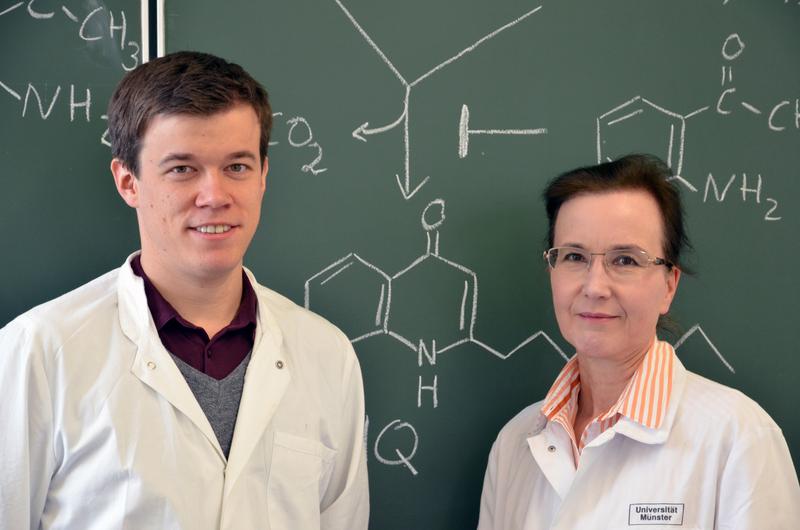

Doctoral student Steffen Drees and Prof. Susanne Fetzner
Photo: WWU/Franziska Birmes
So-called hospital germs are a big worry for physicians and hygiene specialists as these bacteria can spell danger for people with a weakened immune system. This is especially true when the germs are resistant to one or more antibiotics and surround themselves with a so-called biofilm as a sort of protective shield.
Microbiologists at the Universities of Münster and Nottingham, in England, have now analysed an enzyme which might play an important role in the treatment of infections from the hospital germ Pseudomonas aeruginosa. They have decoded the three-dimensional structure of the enzyme and revealed its function.
Their work has been published in the latest issue of the Journal of Biological Chemistry and has been given prominence as “Paper of the Week”. This special honour is awarded to a maximum of 100 articles among the 6,600 and more that are published in the Journal every year.
The Pseudomonas aeruginosa bacterium is the fourth most common pathogen worldwide causing hospital-acquired infections. The germ is widespread and can be found for example in damp places such as washing basins and showers. In the case of people who have a history of illnesses or a weakened immune system, the germ can lead to pneumonia and blood poisoning, among others.
“The bacterium is something that hospital hygienists fear,” says Prof. Susanne Fetzner, who initiated the project – funded by the German Research Foundation (DFG) – and headed the Münster side of it. Pseudomonas aeruginosa forms a large number of so-called virulence factors. These include cytotoxins and tissue-damaging enzymes which help the bacteria to repel a person’s immune defence and make it easier for the pathogens to spread in the body.
As problems resulting from resistances to antibiotics are on the increase, scientists worldwide are following up new therapeutic techniques. These include the development of substances with an anti-virulent effect which do not impede the growth of bacteria, but instead block the formation of the virulence factors.
The enzyme the scientists in Münster and Nottingham analysed plays an important role in the production of the virulence factors of Pseudomonas aeruginosa. If this enzyme could be deactivated though medication, the bacteria would not develop pathogenic properties in the first place.
Steffen Drees, a doctoral student and the lead author of the study, explains this approach: “Bacteria such as Pseudomonas aeruginosa have a very interesting property: they communicate with one another by means of signal molecules. This enables them to sense how many bacterial cells there are in their vicinity. Only when the 'army' is strong enough the bacteria will start to produce their virulence factors.
If the enzyme we have analysed were blocked by means of medication, the bacteria would no longer be able to form any signal molecules. This means they would not notice that the population had reached the necessary high density of bacterial cells – and, accordingly, they would not form any virulence factors.”
This enzyme is not the only bacterial protein which could be a target for therapeutic agents at the molecular level. Other studies show alternatives. “The enzyme we have analysed, however, is particularly promising,” says biologist Susanne Fetzner, “because it is a key enzyme in the formation of signal molecules – and therefore of virulence factors.” The scientists see their work as a first step towards a possible new therapy. “First you need to understand an enzyme in order to be able to develop agents which can deactivate it. And that we have achieved.”
Original publication:
Drees S. L., Li C., Prasetya F., Saleem M., Dreveny I., Williams P., Hennecke U., Emsley J. und Fetzner S. (2016): PqsBC, a condensing enzyme in the biosynthesis of the Pseudomonas aeruginosa quinolone signal: crystal structure, inhibition, and reaction mechanism. The Journal of Biological Chemistry; doi: 10.1074/jbc.M115.708453
http://www.jbc.org/content/291/13/6610.abstract Online version of the original publication
http://www.jbc.org/content/291/13.cover-expansion Cover image of the “Paper of the Week”












